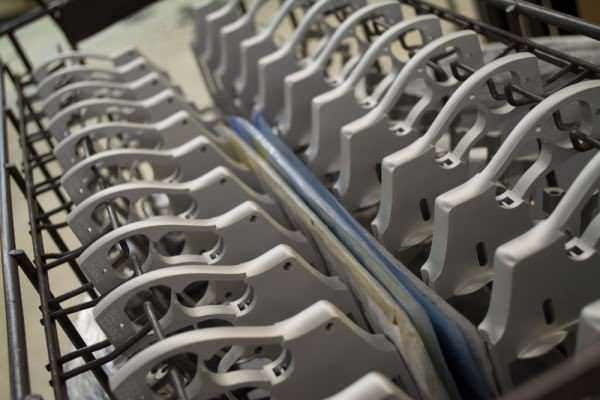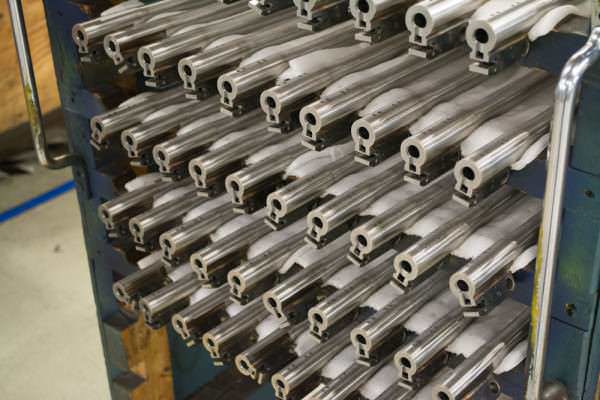
USA – -(Ammoland.com)- Firearms and ammunition companies that share technical data or defense services controlled by the International Traffic in Arms Regulations (ITAR) with foreign partners will be big beneficiaries of Export Control Reform (ECR).
Your company is among the beneficiaries if it engages in any of the following activities with regard to non-automatic or semi-automatic firearms:
- Exchange of firearm- or ammunition-related technical data or defense services with foreign parent companies or affiliates;
- Sourcing parts or tools from offshore vendors;
- Joint design and development of firearm or ammunition products with foreign partners.
Dramatic differences between the way the ITAR and the Export Administration Regulations (EAR) control exports of technical data and defense services underlie these exciting changes:
- There is no analog under the EAR to the ITAR concept of “defense services.” Services simply are not controlled under the EAR.
- The EAR control a narrower scope of technical data than the ITAR. (Note: technical information that is referred to as “technical data” under the ITAR is referred to as “technology” under the EAR.)
- There are no Manufacturing License Agreements or Technical Assistance Agreements under the EAR. In the more limited circumstances when a license will continue to be required after ECR takes effect, a regular export license under the EAR is all that will be required.
- There is no requirement for Congressional Notification under the EAR as there is under the ITAR for certain transactions. This means that collaborations with foreign parties that currently require Congressional Notification will be approved much more quickly if they continue to require a license under the EAR.
Let’s dive into the practical benefits of these changes and also take a look at what they mean for existing ITAR agreements and the way you should think about foreign collaborations between today and the likely effective date of Export Control Reform in 2019.
Collaborate with foreign affiliates without ITAR agreements
Quite a few U.S. companies in the firearms and ammunition industry are owned by non-U.S. parent companies. When the U.S. company and the foreign parent want to collaborate on designing new products or modifying existing products, the ITAR get in the way. An ITAR Technical Assistance Agreement (TAA) or Manufacturing License Agreement (MLA) generally must be approved by the Department of State, Directorate of Defense Trade Controls (DDTC) before the collaboration can begin. Preparation and administration of ITAR agreements are considerably more difficult than with ordinary ITAR licenses (DSP-5s). If the collaboration will involve the production of complete firearms or major components outside the U.S. or is valued at $1 million or more, notice to Congress is required, which delays approval of the agreement by months.
There are no agreements or Congressional Notification under the EAR. When a U.S. company wishes to collaborate with a foreign parent or affiliate, the U.S. party will need to analyze whether the collaboration will involve the exchange (i.e., export) of EAR “technology” with the foreign affiliate. “Technology” under the EAR has a narrower definition than “technical data” under the ITAR, as well as a broader carve-out for information in the public domain, but product design, development and production collaborations will generally continue to require U.S. Government authorization. Under the EAR, however, the authorization will be a simple technology export license identifying the technology that will be exported, the recipients and the purpose. It will be much easier to prepare than an ITAR MLA or TAA.
ECR also will reduce another thorny problem associated with collaborations within multinational companies. When U.S. companies participate in design, development or production activities with foreign affiliates, the ITAR require DDTC approval of all foreign countries into which the affiliates sell products they manufacture that contain any fruits of the collaboration or U.S. origin hardware, even very small amounts. The understandable reluctance of some foreign companies to become subject to ITAR restrictions inhibits their willingness to engage in collaborations with U.S. affiliates that would be mutually beneficial and good for consumers.
The EAR contains a concept of de minimis U.S. content that should significantly alleviate foreign companies’ concern that even a small amount of “U.S. content” contributed by their U.S. affiliates will subject them to U.S. export controls. Generally speaking, foreign manufactured products that contain 25% or less U.S. EAR-controlled content will not be subject to U.S. export controls. This will be a very significant change.

Sourcing parts and tools outside the U.S. will no longer require ITAR agreements or rigid offshore procurement licenses.
Export Control Reform will very significantly reduce the ITAR-driven red tape associated with buying parts and manufacturing tools for non-automatic and semi-automatic firearms from foreign vendors.
Normal interaction between a manufacturer and its suppliers – sending prints and collaborating among manufacturing engineers to ensure that vendors’ products meet the applicable specs – generally requires a TAA or MLA under the ITAR when the vendor is located outside the U.S.
These constraints will completely go out the window after ECR with respect to Canadian vendors. No license will be required to exchange prints and other EAR “technology” with Canadian-based suppliers and there will no need for a license in order to provide assistance that is considered “defense services” under the ITAR.
As for the rest of the world (other than a handful of countries, including China), a simple EAR technology export license is all that will be required for a U.S. manufacturer to export the technical data and/or services foreign suppliers need to perform their work. As under the ITAR, it will remain necessary under the EAR to obtain a license before prints can be sent to foreign vendors in countries other than Canada, but, with proper planning, manufacturers will be able to have licenses in place before they are needed.
There is a cherry on the top of this happy change – these sourcing opportunities will be available for all parts that are common to both non-automatic firearms and automatic firearms. Parts that are common to both ITAR and EAR firearms will be controlled under the EAR, not the ITAR.
Joint design and development collaborations with non-U.S. partners will be faster and less expensive to launch.
Design and development activities between U.S. companies and foreign counterparties will be affected in the same way as offshore sourcing, discussed above.
Joint design and development collaborations that require a TAA today will require simple EAR licenses after ECR takes effect, except when the non-U.S. parties are Canadian citizens located in Canada, in which case no license will be required.
How will the new rules affect existing TAAs and MLAs?
Companies with TAAs and MLAs that will be in effect on the effective date of the new rules will need to analyze each agreement separately to develop a strategy to transition away from it. Transition rules for agreements are contained in Section 20 of the ITAR Agreement Guidelines (pages 134-41).
Here are some issues you will need to consider. (Note: No one knows today when the new rules will go into effect, but Orchid Advisors assumes for planning purposes that the effective date will occur in the first half of 2019.)
- TAAs and MLAs relating only to items that will remain on the ITAR after ECR. Relatively few firearms and ammunition TAAs and MLAs relate only to items that will remain on the ITAR (remember that parts common to ITAR items and EAR items will move to the EAR). Those agreements will not be affected by ECR. They will continue to be subject to the ITAR in all respects.
- TAAs and MLAs relating only to items that will move to the EAR. Many TAAs and MLAs relate only to items that will transition from the ITAR to the EAR when the new rules become effective. Those agreements will continue in effect after the new rules become effective, but certain significant changes will start immediately. Most companies with agreements that relate only to transitioning items will want to have a plan for replacing them with EAR licenses sooner rather than later, as discussed below.
Points to consider with respect to agreements dealing only with items moving to the EAR are as follows:
- Agreements in effect on the effective date of the new rules (“legacy agreements”) will terminate three years after the effective date of the new rules unless they were scheduled to expire before that time.
- Exports, re-exports and retransfers of transitioning technical data will continue to be authorized without any new EAR licenses for three years unless the agreement expires sooner. Immediately upon the effective date, “defense services” relating to transitioning items will no longer require U.S. Government authorization in the agreement or otherwise.
- It will be possible to terminate certain agreements after the effective date without replacing them. For instance, TAAs and MLAs with Canadian partners that relate only to non-automatic or semi-automatic firearms, components or accessories and that do not include any parties or nationals from other countries will no longer require any license at all – none of the activities authorized by will be controlled under the EAR. More generally, ITAR agreements that are necessary only to authorize defense services or to authorize exports of “technical data” not included in the EAR definition of “technology” can be terminated when ECR takes effect. Each agreement will need to be looked at carefully, however, before deciding it is no longer necessary.
- Hardware exports in furtherance of legacy agreements that are initiated after the effective date will need to be licensed under the EAR rules. “In furtherance of” DSP-5 licenses will no longer be processed by the Directorate of Defense Trade Controls (DDTC) after the effective date of ECR if they only encompass hardware that has moved to the EAR. “In furtherance of” DSP-5s approved prior to the effective date will remain valid, however, for the goods, they cover, even if the goods have migrated to the EAR before being shipped.
- Material amendments of TAAs and MLAs that only involve items transitioning to the EAR won’t really be possible. So, when it is necessary to increase the scope, value or territory of the agreement, or to add parties, that will be done via new EAR licenses.
The bottom line regarding agreements covering only transitioning items is that it makes sense to bite the bullet and replace them with EAR licenses with some alacrity after the effective date of ECR. It is a good idea to learn how to benefit from the new rules as soon as possible and hanging on to legacy ITAR agreements will inhibit that. The EAR will permit everything that ITAR agreements do with no need to track exports of defense services and a reduced scope of EAR “technology” versus ITAR “technical data”. For companies that will no longer be engaged in any ITAR-controlled activities after the effective date, abandoning legacy ITAR agreements will allow those companies to devote 100% of their export-compliance attention to the EAR.
- 3 Agreements relating to both transitioning and non-transitioning items. The advice above to move away from TAAs and MLAs quickly after the effective date of ECR will not necessarily apply to agreements that cover both transitioning and non-transitioning items. Agreements covering both types of items will remain in effect for up to three years following the effective date of ECR, by which time they will need to be amended to remove the items that will have transitioned to the EAR. Until that time, it will be possible to include transitioning (i.e., EAR) hardware on DSP-5 “in furtherance of” licenses that also include continuing ITAR items, so keeping mixed agreements in effect may sometimes be a good idea.

Consider carefully before proceeding with new TAAs and MLAs.
Between now and the effective date of ECR, it is advisable to find ways to avoid pursuing new ITAR agreements that relate only to items that under the proposed rules will move to the EAR. As noted above, there will be reasons to transition away from existing ITAR agreements promptly after ECR takes effect, so new agreements approved this year are likely to have a very short life. In addition, if it is possible to wait, obtaining an EAR license after the new rules take effect will be easier than crafting a new agreement.
For new agreements requiring Congressional Notification under the ITAR but which cover only transitioning items, one should consider whether an agreement filed now will even be approved before the new rules take effect. It may be more practical simply to wait and file an appropriate EAR license when the effective date arrives.
Lest there be any doubt, the new rules are only proposed rules at this time and they won’t take effect for many months. Until the new rules take effect, the ITAR remains in effect. Despite the publication of the proposed new rules, collaborative activities that require a TAA or MLA today will continue to require an agreement until the final new rules go into effect. The best one can do today is to prepare.
How can Orchid Advisors help?
Orchid Advisors, the #1 provider of regulatory compliance solutions to the firearms and ammunition industry, is committed to showing the industry how to use ECR to do international business and other affected activities more easily and efficiently than they can today.
Orchid’s ITAR / EAR Practice helps companies in the firearms and ammunition industry (i) sell firearms, ammunition, components, and accessories to foreign customers, (ii) build sustainable export compliance programs, and (iii) design, source and manufacture firearms, components, tools and accessories outside the United States.
Look to Orchid Advisors to help you take command of the new ECR export environment in the following ways:
- Formulation of EAR-driven international sales and sourcing strategies.
- Technology solutions for reducing the cost and increasing the speed of export license determinations, license preparation, and related activities.
- Preparation of export licenses and provision of other “export compliance department” services on an outsourced basis.
- Practical advice on making near-term decisions under the ITAR that will be affected in 2019 by the new rules.
- Development of integrated export and ATF compliance solutions for transitioning to the post-ITAR world.

Orchid Advisors assists firearms manufacturers, distributors, and retailers in achieving compliance and operational excellence through education, technology, software and consulting solutions that reduce risk, cut costs and provide expert guidance to make our client’s business more successful and efficient. Orchid Advisors is the trusted firearms industry compliance & operations experts and is endorsed by the National Shooting Sports Foundation.
For more information, visit www.orchidadvisors.com.

If ANYONE, but the lawyers, have waded through this crap you’ve concluded a long time ago that A: ITAR was ill conceived and slapped together with absolutely no thought given to the FFL holder and the ramifications that would be financially dumped on him/her and B: it was so verbose that ONLY lawyers could understand it! Now, for those who want a simple explanation of this latest statement, they’re trying to eliminate the authority ITAR has over small arms and ammunition exports and licensing and place it under another agency. COME ON! Didn’t you learn the first time? If you… Read more »